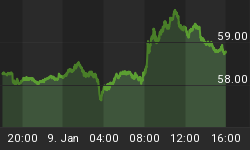Correlations Remain Strong
Correlations between different product groups continue to be the main theme across financial markets. Be it oil, equities or bonds, over the past 3 years there has been a tendency for many asset classes to move up and down together. Today we are close to seeing all asset classes move down together. The rush to exit will bring the US Dollar back to its "king" status.
Since September of 2008 to present day, the correlation between a broad index of commodities - The Rogers International Commodity Index - and the S&P 500 Index has been positively strong, travelling above 0.5 correlation. This correlation is yet to break down, and in times of crises will only strengthen as it did in 2008/09.
And as with mechanics of leverage, if assets are sold en-masse, the single beneficiary will become the US Dollar. It still is, and for the near future will be, the world's reserve currency and is what most of global commodities and asset classes are priced in. Naturally when you sell an asset you receive cash in hand. That cash being US Dollars. Any fire sale of assets will naturally lead to a suction demand for cash and a strong bid to the US Dollar Index. And with correlations being as strong as they are, we can expect that most asset classes will fall together making the rally in the US Dollar ever so strong.

Speculative Fever In the Air
There exists unfounded fear in the financial world about the threat of U.S. debt monetization. As we have shown previously in "The Great Misunderstanding" cash is mostly sitting in the banks vaults in the form of cash reserves. Any spending programs undertaken by the government are used to offset the level of deleveraging and savings in the private sector. As long as this process is controlled, monetary inflation will not spiral out of control. What may spiral out of control - and much of what we have seen - is the speculative fever in global macro trends. To highlight this point, the team at Gluskin Sheff plotted a nice chart showing the levels of margin debt in accounts held at trading brokers. It is designed to imply that the higher the levels of margin debt, the more speculative the trading world and the higher the risks of another crash in highly leveraged asset classes. Equities, currencies and commodities being the most over leveraged products.

It sure is a casino out there. The ratio of the Russell 2000 Index (small cap) over the Dow Jones Index (large cap) has traded at highs not seen since 2006. When people are in a speculative mood, the small capitalized stocks are the ones most traded as the willingness to throw dice hoping for outdated odds increases. Meanwhile, the large cap stocks - those the economy most depends on - will suffer as the economy suffers. Just prior to the financial crisis was at all time high. We are now back to the same highs. Hope is high.

Below we highlight the divergence between our luxury/defense indicator and the S&P 500 Index. Our luxury over defense indicator is designed to highlight the level of optimism and complacency in financial markets. In good times, people pay more for the finer things in life, while Smith and Wesson -the producers of handheld pistols - and other companies in the defense sector rally during recessions. We are near all time highs for this indicator, but today, just as with the price action in 2007, we are seeing the luxury/defense indicator diverge from current price trends. Not a good sign.

The Lone Dollar Bull
A good measure of sentiment towards the US Dollar can be shown when you look at the number of non-commercial speculative positions, longs minus shorts. This measure has now broken below 2009 bearish levels, but remains above the bearish lows seen in 2007.
This shows that people are more bearish than they were in 2009, despite the level of the Dollar Index being above 2009 prices. It has bullish implications for the US Dollar.
While we understand that markets do have the tendency to extend beyond what most people think possible, we would ask readers to consider putting more of their funds into cash over any other asset class. Volatility lies ahead room to the upside in equities and commodities is limited.

Oil Bulls Push To Extreme
Peak Sentiment, Peak Prices. That is the contrarian in us sounding warning signs. We took a look at the number of speculative long positions in oil futures contracts as a spread to the speculative shorts. What we found - in the chart attached - is a record number of long positions in the contracts history. A far second was the oil spike of 2008 when prices traded over $148 a barrel. Today, prices are more than $40 off that high yet the bullish positions on the futures market is about 125,000 more than that of 2008. It is a crowded a trade and while the events in the middle east are never reassuring, one thing for certain is that crowded trades never last long. We need to place emphasis on only one outcome that send the oil prices yet higher. And that would require an all out war between Saudi Arabia and Iran. A scenario which everyone would want to avoid and is only a small possibility. Given no war, we are now bearish oil.
















